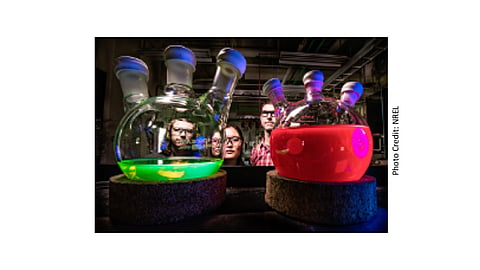

The US National Renewable Energy Laboratory (NREL) for the first time discovered how to make perovskite solar cells out of quantum dots and achieved 10.77% conversion efficiency using this technology. The research has been published in Science magazine on October 7, 2016.
The research team also discovered that in quantum dots, the crystal structure of an all-organic perovskite material at room temperature remains stable. This material was previously only favorable at high temperatures.
Using inorganic quantum dots
NREL describes the quantum dots as "nanocrystals-of cesium lead iodide or CsPbI3 to remove the unstable organic component and open the door to high-efficiency quantum dot optoelectronics that can be used in LED lights and photovoltaics."
According to NREL, the nanocrystals of CsPbI3 were synthesized through the addition of a Cs-oleate solution to a flask containing PbI2 precursor. The researchers purified the nanocrystals using methyl acetate as an anti-solvent that removed excess unreacted precursors. NREL says that this step turned out to be critical to increasing their stability.
Contrary to the bulk version of CsPbI3, NREL found that the nanocrystals to be stable not only at temperatures exceeding 600°F but also at room temperatures and at hundreds of degrees below zero. NREL says that the bulk version of this material is unstable at room temperature, where photovoltaics normally operate and convert very quickly to an undesired crystal structure.
Titled Quantum dot-induced phase stabilization of a-CsPbI3 perovskite for high-efficiency photovoltaics, the researchers repeatedly dipped nanocrystals into a methyl acetate solution to achieve a thickness of 100 to 400 nm. Post this process when used in a solar cell,the CsPbI3 nanocrystal film was able to convert 10.77% of sunlight into electricity. The report claims, "The efficiency is similar to record quantum dot solar cells of other materials and surpasses other reported all-inorganic perovskite solar cells."
Since 2009 when research began on perovskites for PV, their efficiency has increased to over 22%, but this has been on hybrid organic-inorganic structures. But organic materials have been a big headache for perovskites development towards commercial cells. At the EU PVSEC conference in June in Munich, Prof. Martin Green from UNSW in New South Wales, who was first very enthusiastic about the quickly improving efficiencies of perovskites, stated that the technology has disappointed so far as it has not been able to deliver long-term stability products.
NREL's research was funded in part by the Energy Department's Office of Science and by the SunShot Initiative. NREL is the U.S. Department of Energy's primary national laboratory for renewable energy and energy efficiency research and development. The SunShot Initiative is a collaborative national effort that aggressively drives innovation to make solar energy fully cost-competitive with traditional energy sources before the end of the decade. Through SunShot, the Energy Department supports efforts by private companies, universities, and national laboratories to drive down the cost of solar electricity to $0.06 per kWh.
